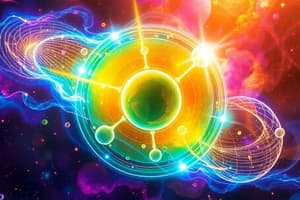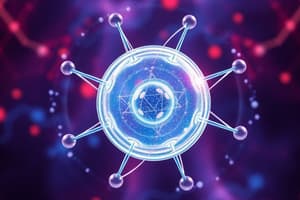Podcast
Questions and Answers
Which of the following correctly defines the effective nuclear charge?
Which of the following correctly defines the effective nuclear charge?
- The charge experienced by a valence electron in an atom, without considering the shielding effect of inner electrons.
- The charge of the nucleus in an atom.
- The total charge experienced by all the electrons in an atom.
- The total charge experienced by a valence electron in an atom, taking into account the shielding effect of inner electrons. (correct)
What is polarization?
What is polarization?
- The process of aligning the electron cloud of an atom or molecule in response to an external electric field. (correct)
- The process of aligning the electron cloud of an atom or molecule in response to an external magnetic field.
- The process of breaking an ionic bond.
- The process of breaking a covalent bond.
Which of the following compounds has a higher melting point and why?
Which of the following compounds has a higher melting point and why?
- BeCl2, because it has stronger ionic bonds.
- BeCl2, because it has stronger covalent bonds.
- BaCl2, because it has stronger ionic bonds. (correct)
- BaCl2, because it has stronger covalent bonds.
According to Fajan's rule, how can the development of covalent character in ionic compounds be explained?
According to Fajan's rule, how can the development of covalent character in ionic compounds be explained?
What is the effective nuclear charge of a 3d electron in the Zn atom?
What is the effective nuclear charge of a 3d electron in the Zn atom?
Flashcards are hidden until you start studying




